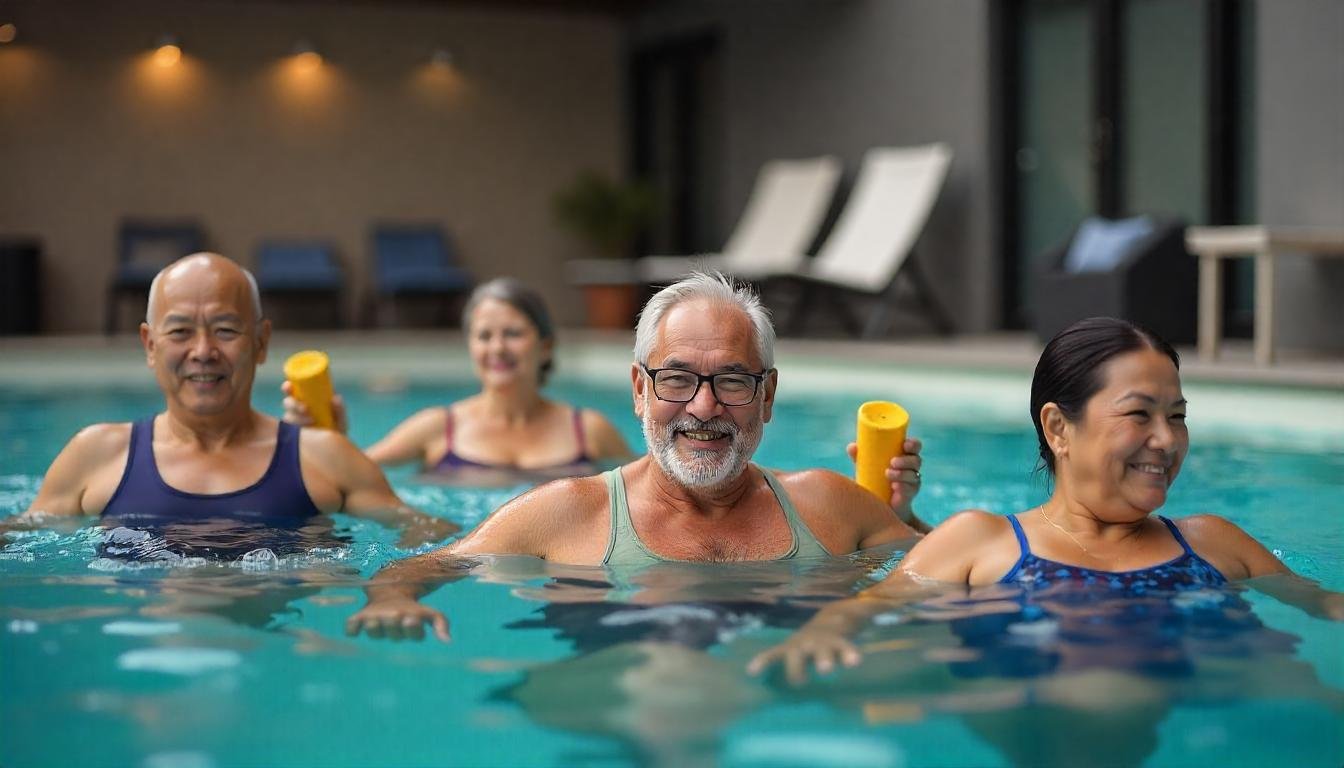Introduction:
This article will discusses about Low-Impact Exercises for Seniors with Arthritis . Arthritis is a common condition affecting millions of seniors worldwide, leading to joint pain, stiffness, and decreased mobility. While medication and therapy can help manage symptoms, regular physical activity—especially low-impact exercises for seniors with arthritis—plays a vital role in improving joint flexibility, reducing pain, and enhancing quality of life. This article explores science-backed, gentle strength exercises arthritis seniors workouts tailored for older adults with arthritis.
Table of Contents
Why Low-Impact Exercise Matters for Seniors with Arthritis
Understanding low-impact exercises for seniors with arthritis
Among the many types of arthritis, osteoarthritis and rheumatoid arthritis are the most prevalent in older adults. Osteoarthritis is often referred to as a “wear-and-tear” condition. Over the years, the cartilage that cushions the joints naturally starts to break down. This degeneration leads to pain, stiffness, swelling, and reduced range of motion. Imagine your joints as shock absorbers—without that smooth cartilage, even simple movements like standing or walking can become uncomfortable or painful.

On the other hand, rheumatoid arthritis is an autoimmune condition, where the immune system mistakenly attacks the joints, causing chronic inflammation. This can lead to joint deformity and significant pain if left unmanaged. While the two conditions are different in cause, their impact on daily living—especially among seniors—is often quite similar.
What’s even more concerning is that inactivity, often a response to pain, can actually make symptoms worse. When seniors stop moving, muscles around the joints begin to weaken. This leads to muscle atrophy, which in turn places more stress on the joints, creating a vicious cycle of worsening pain and further immobility. Staying active—within a safe, low-impact range—is not just beneficial; it’s essential for maintaining independence and quality of life.
Benefits of low-impact exercises for seniors with arthritis
- Enhances joint flexibility
- Reduces inflammation
- Improves cardiovascular health
- Strengthens supporting muscles
- Boosts mood and sleep quality

“Exercise is crucial for arthritis management. Low-impact activities reduce joint stress while keeping you mobile.” — Arthritis Foundation
Best Low-Impact Exercises for Seniors with Arthritis
1. Chair Yoga
Gentle and supportive, chair yoga enhances flexibility and promotes relaxation.
- Promotes joint lubrication and muscle strength
- Can be done at home or in groups
- Poses: Seated cat-cow, overhead stretch, ankle rolls

2. Aquatic Exercises for Arthritis Pain Relief
Water buoyancy supports joints, making movement easier and less painful.
- Water aerobics and pool walking are highly recommended
- Reduces joint impact and promotes muscle activation
3. Tai Chi
An ancient martial art that enhances balance, coordination, and flexibility.
- Increases range of motion
- Helps prevent falls
- Improves mental well-being

4. Walking Exercises for Arthritis Seniors
Walking is one of the most accessible, low-cost, and effective ways to stay physically active, making it suitable for people of nearly all ages and fitness levels. It requires no special equipment, can be done almost anywhere, and offers a wide range of health benefits—including improved cardiovascular health, better joint mobility, enhanced mood, and weight management. Even a brisk 20- to 30-minute walk each day can contribute to meeting weekly physical activity goals, support mental clarity, and reduce the risk of chronic diseases. Plus, walking can easily be modified in pace or duration to match your current fitness level or health condition.
- Wear supportive shoes
- Start slow, increase time gradually
- Avoid uneven terrain
5. Resistance Band Workouts
Engaging in light strength training can significantly help strengthen the muscles surrounding the joints, which in turn enhances joint stability, reduces strain, and improves overall function. By building supportive muscle groups, you create a protective buffer that helps absorb stress and reduce wear on the joints themselves. This form of exercise is especially beneficial for individuals with arthritis, osteoporosis, or chronic joint pain, as it promotes mobility and reduces the risk of injury without overloading the joints. When done with proper form and guidance, even light resistance exercises can yield meaningful improvements in strength, balance, and daily movement efficiency.
- Use low-resistance bands
- Focus on major muscle groups
- Keep movements slow and controlled

6. Elliptical & Stationary Biking
Delivers an effective cardiovascular workout while minimizing stress and impact on the joints, making it an ideal choice for individuals with arthritis, joint pain, or those recovering from injuries.
- Good alternative to arthritis knee walking plan seniors
- Start with short sessions

7. Balance and Core Workouts
Improves stability, reduces fall risk.
- Heel-to-toe walk
- Leg raises
- Core stretches

Creating a Safe and Effective Exercise Plan
Tips for Getting Started
- Consult your doctor before beginning any new routine
- Start slow and listen to your body
- Stay hydrated and wear appropriate footwear
- Warm-up and cool-down are essential
Example Schedule:
| Day | Activity |
|---|---|
| Monday | Chair Yoga (20 mins) |
| Tuesday | Walking (15 mins) |
| Wednesday | Aquatic Aerobics (30 mins) |
| Thursday | Tai Chi (20 mins) |
| Friday | Resistance Bands (20 mins) |
| Saturday | Balance Training (15 mins) |
| Sunday | Rest or Gentle Stretching (10 mins) |
Precautions and When to Stop
- Stop if you experience sharp pain, swelling, or dizziness
- Avoid high-impact movements (jumping, sudden direction changes)
- Use mobility aids if needed
- Work with a physical therapist if necessary
Conclusion
low impact arthritis exercises at home are a safe, natural way for seniors to manage arthritis and stay active. Whether it’s a gentle yoga session, water aerobics, or a short walk, consistency is key. These workouts can significantly improve mobility, reduce pain, and support mental health.
Call to Action: Before beginning any new exercise program, it is strongly recommended that you consult with your healthcare provider or a licensed physical therapist—particularly if you are dealing with chronic joint pain, arthritis, previous injuries, cardiovascular conditions, or any other ongoing medical concerns. A professional evaluation can help ensure that your fitness routine is safe, appropriately tailored to your individual health needs, and aligned with your long-term wellness goals.
FAQs
1. What are the best low impact workouts for senior arthritis?
Low-impact exercises such as chair yoga arthritis relief, water aerobics, tai chi, and walking are widely recognized as some of the safest and most effective physical activity options—particularly for older adults, individuals with joint pain or mobility limitations, and those recovering from injury. These gentle yet beneficial forms of movement can help improve flexibility, balance, cardiovascular health, and overall well-being without placing excessive strain on the joints or increasing the risk of injury.
2. Can exercise worsen arthritis pain?
That’s not necessarily the case—when performed correctly, low-impact exercises are designed to help reduce pain rather than aggravate it. Activities such as walking, swimming, gentle stretching, or tai chi can actually support joint function, improve circulation, and enhance overall mobility. However, it’s crucial to start slowly, listen to your body, and build up intensity gradually. Always consult with a healthcare professional or physical therapist beforehand to ensure the chosen exercises are safe and appropriate for your individual health needs and physical limitations.
3. How often should seniors with arthritis exercise?
Most health and fitness experts, including those from the World Health Organization and the CDC, recommend engaging in at least 150 minutes of moderate-intensity aerobic activity each week. Ideally, this should be spread out over 3 to 5 days to allow for adequate recovery and to maintain consistency. This can include activities like brisk walking, swimming, cycling, or water aerobics, and can be broken down into manageable sessions—such as 30 minutes a day, five times a week. Regular physical activity at this level supports heart health, improves stamina, strengthens muscles, and helps manage chronic conditions like arthritis or diabetes.
4. Are resistance bands safe for arthritis patients?
Yes, when used correctly and under proper guidance, resistance bands can be an excellent tool for strengthening muscles without placing excessive stress on the joints. They provide controlled tension throughout the movement, allowing for smooth, low-impact resistance that can be easily adjusted to match an individual’s strength level and range of motion. This makes them especially beneficial for older adults, individuals recovering from injury, or anyone dealing with joint pain or arthritis. When incorporated into a well-designed exercise program, resistance bands can help improve muscular endurance, stability, and overall functional fitness—safely and effectively.
5. Where can I find a downloadable arthritis workout plan?
Many organizations like Arthritis Foundation and Mayo Clinic offer free PDF plans or videos online.
External Sources & Citations:
- Mayo Clinic (www.mayoclinic.org)
- Arthritis Foundation (www.arthritis.org)
- PubMed (www.ncbi.nlm.nih.gov/pubmed)
- CDC Exercise Guidelines (www.cdc.gov)
Internal Links:
- [Beginner’s Guide to Tai Chi for Pain Relief]
- [Best Home Fitness Equipment for Seniors]
- [Understanding Osteoarthritis: Causes & Symptoms]



